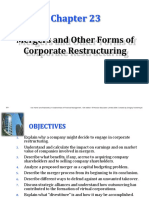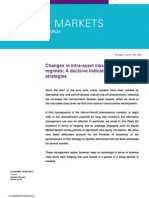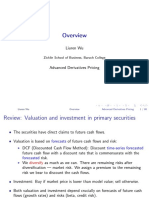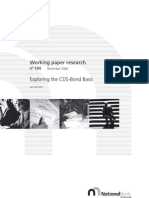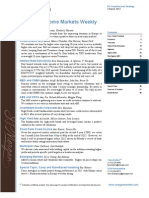ACOMB-Correlation in Practice
Uploaded by
floqfloACOMB-Correlation in Practice
Uploaded by
floqflo1
Why People Who Price Derivatives
Are Interested In Correlation
Simon Acomb NAG Financial Mathematics Day
Correlation Risk
What Is Correlation
2
No linear relationship between points Co-movement between the points
Positive correlation
Simon Acomb NAG Financial Mathematics Day
Correlation Risk
Stochastics
3
Standard pricing theory is based on some general stochastic description on the
dynamics of the underlying asset.
With two, or more assets
dSt1
= µ 1dt + σ 1dZ 1
St1
dSt2
2
= µ 2 dt + σ 2 dZ 2
St
Μ
dStn
= µ n dt + σ n dZ n
Stn
dZ i , dZ j = ρ ij dt
Need a correlation matrix is specify the dynamics.
Simon Acomb NAG Financial Mathematics Day
Correlation Risk
Products With Correlation Exposure
4
1. Quanto Option
+
S JPY
T
NUSD 0 −1
S JPY
Imagine that the share price is 100JPY and the delta is 1. In this case fund of
the hedge is done in JPY. If FX rates move then the JPY of the contract
moves, but the value of the hedge does not. Weak exposure to the correlation
between FX and Equity
2. Compositive (Cross) Option
+
X USD
JPY T
S
NUSD JPY JPY 0
−1
X USD S JPY
Like an option on a ADR. Every time we trade delta we fund in USD. Volatility
is the volatility of S measured in USD. Strong exposure to FX and Equity
correlation.
Simon Acomb NAG Financial Mathematics Day
Correlation Risk
Products With Correlation Exposure
5
1. Spread Option
+
ST1 ST2
1 − 2 − K
S0 S0
2. Best-of, Worst-Of options
+ +
i i
Ma x STi − K Min STi − K
i S i S
0 0
3. Basket Options
+
i
∑ wi STi − K
i S
0
4. Himalayan Options
+
Si
w Max ti −K
∑ i
remaining i S i
i 0
5. Rainbow Options
+
i Si
w1 Max STi + w2 Min Ti − K
i S
0 i
S0
Simon Acomb NAG Financial Mathematics Day
Correlation Risk
Basket Options
6
• Very commonly traded
• Can be traded with the OTC market together with short positions in options on
each of the underlyings – a correlation product
• Approximations for basket variance
σ basket
2
≈ ∑ wi w j ρ ijσ iσ j
i, j
(Note this is only an approximation as assets are lognormally distributed.
• Increasing the correlation increases the basket volatility and makes the options
more expensive
• Often sold on diverse set of underlyings to make the option cheaper
• More underlyings in the mix makes the option cheaper.
Simon Acomb NAG Financial Mathematics Day
Correlation Risk
Best-Of / Worst-Of
7
• General idea is that when the correlation is low (negative) there is a more diverse
range of outcomes, hence there will always be one asset which has outperformed
and one that has under performed. (Consider the case of perfect negative
correlation.)
• Following exposure of product to a rise in correlation
Call Put
Best-Of - +
Worst-Of + -
• Frequently components of structured products
• Worst of Call (embedded in a guaranteed product) correlation used to make the product
cheaper
• Short Worst of Put (embedded in reverse convertible) correlation used to increase the
coupon
Simon Acomb NAG Financial Mathematics Day
Correlation Risk
Himalayan / Rainbow
8
• Himalayan is like a combination of a basket options and an asian option -
averaging over both time and asset. “Best” assets are fixed early and lose their
time value. Becomes like a call on the worst – positive exposure to correlation
• Rainbow is an interesting product.
Like a basket increasing correlation, increases the value of the product
Typically the product is set up with the highest weight applied to the best
performing asset, and so has some features of a call on the best – increasing
correlation, decreases the value of the product
Overall product has small correlation exposure, but it can be either positive, or
negative.
Simon Acomb NAG Financial Mathematics Day
Correlation Risk
Typically Investment Bank Exposure
9
Typical products that investment banks sell.
• Reverse Convertible on the worst
• Basket options
• Himalayan / Rainbow
• Calls on worst
All leave the seller short correlation. Difficult to manufacture a product which has
correlation exposure in the other direction.
Simon Acomb NAG Financial Mathematics Day
Correlation Risk
Measuring Correlation
10
First attempt would be to use the time series of two underlyings and measure the correlation of
the time series. Rolling window of 6 months daily data Nikkei 225 and S&P 500
Note enormous range. For ρ=0.2 and 6 months daily data – statistic confidence interval is
[0.02, 0.36]. Are we picking up sampling error, or uncertainty in correlation
Correlation is low due to asynchronous effect.
Simon Acomb NAG Financial Mathematics Day
Correlation Risk
Measuring Correlation (Weekly Data)
11
Using a 1 year rolling window
Implied correlation taken from options markets close to 0.70.
Just as volatility trades at a premium to historic, so does correlation.
Need a mechanism that assess this premium.
Simon Acomb NAG Financial Mathematics Day
Correlation Risk
Why Do We Need a Positive Semi Definite Matrices
12
Negative Definite matrix implies that there are portfolios with negative variance.
(In portfolio theory can we get away with this if we insist that all assets have
positive weight ?)
Monte Carlo Path Generation
Given uncorrelated random numbers W j
Zj Ρ
How do we construct random numbers which have the correlation matrix
Q R = QQT Z j = ∑ q jkWk
Find pseudo-square root so that and k
Algorithms for Q require R to be positive semi-definite.
Simon Acomb NAG Financial Mathematics Day
Correlation Risk
Why Do We Get Negative Definite Matrices
13
One would imagine that if we use time series over the same period and estimated
from this the correlation matrix would be positive definite by definition.
• Data is not synchronous. Different regions have different holidays.
• What do you do with the stock that has only just been issued.
In reality correlation matrices suffer from this problem.
For pricing purposes would prefer to use correlations implied from option contracts
that I can see. For example baskets and dispersions.
Most likely going to be mixing historic and implied estimates.
Many people want to know what happens when correlation goes up by 10%.
Simon Acomb NAG Financial Mathematics Day
Correlation Risk
Correlation Premium
14
Useful transform
ρ → ρ + α (1 − ρ )
If covariance matrix is positive semi-definite then this transform will maintain this
property
Gives calibration method for correlation.
1.Estimate correlations by the best historical method you have available
2.From the small number of observations that you can observe estimate the
correlation premium
3.Apply this correlation premium to all historic correlations that you use.
Simon Acomb NAG Financial Mathematics Day
Correlation Risk
Correlation Smile
15
Consider an Index such as the EuroStoxx made up of 50 underlying assets I = ∑ wi Si
i
Then to reasonable approximation
σ I2 = ∑ wi w j ρijσ iσ j
i, j
If volatility is a function of (percentage) strike then ρ must also be a function of this strike.
σ I2 ( K ) = ∑ wi w j ρij ( K )σ i ( K )σ j ( K )
i, j
We know that index volatility smiles are steeper than single stock volatility smiles so not surprisingly we
find that correlation is higher for low strikes than for higher strikes
Simon Acomb NAG Financial Mathematics Day
Correlation Risk
Implied Correlation
16
Simon Acomb NAG Financial Mathematics Day
Correlation Risk
Explanation of Correlation Smile
17
1. We know that distributions of assets are not lognormal. To make more sense
of the information we should be using the implied distributions of each stock.
2. Given the distributions of each asset does not determine the joint distribution of
two assets. There is a extensive theory of this called copula.
3. If we used local volatility as a process we would get very different results.
Correlation smile means many different things to different people.
If trading correlation the most objective way of doing so will be with variance swaps.
Simon Acomb NAG Financial Mathematics Day
Correlation Risk
Products Exposed to Correlation Smile
18
• Dispersion of deep out of the money options
• Far out of the money
• Worst of options
• Worst of digitals
• Way out of the money altiplano products
• Worst of equity default products
Simon Acomb NAG Financial Mathematics Day
Correlation Risk
Measuring Explicit Correlation Risk
19
• Common to measure correlation risk as
ρ → ρ + 10%
• What about correlations at 0.95
• What happens if the correlation matrix is no longer positive definite
• Use the α risk methodology
ρ → ρ + α (1 − ρ )
• α = 10%
ρ = 90% → 91%
ρ = 20% → 28%
• Smaller correlations move the most (in line of empirical observations)
• Maintains positive definiteness.
• Make sure that correlation scenario is sufficiently large to capture any non-
linearity in correlation.
Simon Acomb NAG Financial Mathematics Day
Correlation Risk
Hidden Correlation Risk
20
• Correlation exposure within derivatives exposure is by no-means unique.
• Portfolio managers have been dealing with correlation exposure for a long time
• Common to measure market exposure by moving all assets simultaneously.
• All the same amount
• Scaled by a beta to the market
• If portfolio only had two assets which where negatively correlated then this risk measure
would be in-appropriate
• Portfolio risk systems such as Barra break down risk exposure into other factors.
• Named factors related to real variables
• Principal components
• If you have the break down of delta by asset, worthwhile thinking about whether portfolio
manager techniques can help better understand the correlation of a portfolio whether it has
derivatives in it, or not.
Simon Acomb NAG Financial Mathematics Day
Correlation Risk
Hedging Correlation Exposure
21
Most retail structured products leave the seller short correlation.
Reverse Cliquet on a Basket
+
Bt
Max X − ∑ 1 −
,0
t Bt −1
Reverse Convertible on a Basket
B
Min T ,1
B0
Small number of products which leave the seller long correlation.
Simon Acomb NAG Financial Mathematics Day
Correlation Risk
Hedging Correlation Risk - Dispersion
22
Broker market traders dispersions in vanilla options
S1 S2 S1 S2
Max w1 T1 + w2 T2 − K ,0 − w1Max T1 − K ,0 − w2 Max T2 − K ,0
S0 S0 S0 S0
Can go long or short and hence long, or short correlation.
On initiation product has little individual vega, but has exposure to correlation.
• When share prices move this will no longer be the case.
• Just as the vega of a vanilla option dissipates when the option move away from ATM, so the
correlation exposure of a basket option dissipates as you move away from ATM.
These types of trades are popular with indices.
Simon Acomb NAG Financial Mathematics Day
Correlation Risk
Hedging Correlation Exposure – Variance Swaps
23
Variance Swaps provide a simple way of trading variance without an explicit strike dependency.
Can trade a dispersion of variance swaps
Long variance swap on the EuroStoxx 50
Short variance swaps on each of the individual consistuents.
Can go long or short.
• Possible on the indices with a small number of assets, but can be approximated on indices
such as the S&P with tracking portfolios
• As these are strike-less the correlation exposure does not dissipate as the underlying assets
move.
Simon Acomb NAG Financial Mathematics Day
Correlation Risk
Correlation Swaps
24
A correlation swap is an OTC product which has a payoff given by
2
P= ∑ ρij
N ( N − 1) i < j
Gives a direct way of trading correlation.
• Difficult to hedge product
• Does it really give the exposure you require.
If you mis-estimate correlation between two Geometric Brownian motions
P&L given by terms including
T ∂ 2 f
E ∫ S1S 2σ 1σ 2 ( ρˆ ij − ρ ij )dt
0 ∂S1∂S 2
Covariance swaps will be easier to price.
Simon Acomb NAG Financial Mathematics Day
Correlation Risk
Return to Q-Q Maps
25
Is assumption correlation constant correct.
Should we be using a copula based theory.
Simon Acomb NAG Financial Mathematics Day
You might also like
- Ambrus Capital - Volatility and The Changing Market Structure Driving U.S. EquitiesNo ratings yetAmbrus Capital - Volatility and The Changing Market Structure Driving U.S. Equities18 pages
- DBQuantWeeklyDashboard - 2016 09 19 PDFNo ratings yetDBQuantWeeklyDashboard - 2016 09 19 PDF11 pages
- 6th Ed Module 1 Selected Homework AnswersNo ratings yet6th Ed Module 1 Selected Homework Answers7 pages
- Mergers and Other Forms of Corporate RestructuringNo ratings yetMergers and Other Forms of Corporate Restructuring44 pages
- (AXA Investment) Why The Implied Correlation of Dispersion Has To Be Higher Than The Correlation Swap StrikeNo ratings yet(AXA Investment) Why The Implied Correlation of Dispersion Has To Be Higher Than The Correlation Swap Strike4 pages
- Barclays Capital - The - W - Ides of MarchNo ratings yetBarclays Capital - The - W - Ides of March59 pages
- Pricing and Hedging of Japan Equity-Linked Power Reverse Dual NoteNo ratings yetPricing and Hedging of Japan Equity-Linked Power Reverse Dual Note59 pages
- Barclays UPDATE Global Rates Weekly Withdrawal Symptoms100% (1)Barclays UPDATE Global Rates Weekly Withdrawal Symptoms74 pages
- FI - Cross Currency Swap Theory and Practice (Nicholas Burgess) PDF100% (1)FI - Cross Currency Swap Theory and Practice (Nicholas Burgess) PDF26 pages
- Capital Protected Dispersion CertificateNo ratings yetCapital Protected Dispersion Certificate5 pages
- The Buzz About Bear Flies: Derivative FocusNo ratings yetThe Buzz About Bear Flies: Derivative Focus10 pages
- 2008 DB Fixed Income Outlook (12!14!07)No ratings yet2008 DB Fixed Income Outlook (12!14!07)107 pages
- Expected Return On Bond Portfolio and Decompose Bond PortfolioNo ratings yetExpected Return On Bond Portfolio and Decompose Bond Portfolio12 pages
- Lecture 11: Stochastic Volatility Models ContNo ratings yetLecture 11: Stochastic Volatility Models Cont28 pages
- Barclays US Futures H3-M3 Treasury Futures Roll Outlook PDFNo ratings yetBarclays US Futures H3-M3 Treasury Futures Roll Outlook PDF9 pages
- JPM A Framework For Cred 2007-11-19 164750100% (1)JPM A Framework For Cred 2007-11-19 16475052 pages
- Dynamics of Interest Rate and Equity VolatilityNo ratings yetDynamics of Interest Rate and Equity Volatility9 pages
- Artemis Capital Q12012 Volatility at Worlds End1No ratings yetArtemis Capital Q12012 Volatility at Worlds End118 pages
- Qis - Insights - Qis Insights Style InvestingNo ratings yetQis - Insights - Qis Insights Style Investing21 pages
- Quantitative Strategies Research Notes: Static Options ReplicationNo ratings yetQuantitative Strategies Research Notes: Static Options Replication42 pages
- Strategic Asset Allocation in Fixed Income Markets: A Matlab Based User's GuideFrom EverandStrategic Asset Allocation in Fixed Income Markets: A Matlab Based User's GuideNo ratings yet
- CLO Liquidity Provision and the Volcker Rule: Implications on the Corporate Bond MarketFrom EverandCLO Liquidity Provision and the Volcker Rule: Implications on the Corporate Bond MarketNo ratings yet
- Japan's Lost Decade: Origins, Consequences, and Prospects For RecoveryNo ratings yetJapan's Lost Decade: Origins, Consequences, and Prospects For Recovery28 pages
- Heath-Jarrow-Morton Framework: Jeff GrecoNo ratings yetHeath-Jarrow-Morton Framework: Jeff Greco12 pages
- Sworn Statement of Assets, Liabilities and Net WorthNo ratings yetSworn Statement of Assets, Liabilities and Net Worth3 pages
- Investopedia - Financial Ratio TutorialNo ratings yetInvestopedia - Financial Ratio Tutorial55 pages
- Problems and Prospects of Tourism: A Case Study of Namoboudha, KavreNo ratings yetProblems and Prospects of Tourism: A Case Study of Namoboudha, Kavre21 pages
- Financial Review: World's First Corporate Bonds To Tackle Plastic WasteNo ratings yetFinancial Review: World's First Corporate Bonds To Tackle Plastic Waste30 pages
- Swiggy Needs To Answer These Key Questions Before The IPO - The Economic TimesNo ratings yetSwiggy Needs To Answer These Key Questions Before The IPO - The Economic Times5 pages
- Finder'S Fee Agreement: This Agreement Is Made This 5 Day of January 2009No ratings yetFinder'S Fee Agreement: This Agreement Is Made This 5 Day of January 200911 pages
- JP Morgan Chase Company: Navarro, Antonette Louisse L. BSA-1DNo ratings yetJP Morgan Chase Company: Navarro, Antonette Louisse L. BSA-1D2 pages
- Ambrus Capital - Volatility and The Changing Market Structure Driving U.S. EquitiesAmbrus Capital - Volatility and The Changing Market Structure Driving U.S. Equities
- Mergers and Other Forms of Corporate RestructuringMergers and Other Forms of Corporate Restructuring
- (AXA Investment) Why The Implied Correlation of Dispersion Has To Be Higher Than The Correlation Swap Strike(AXA Investment) Why The Implied Correlation of Dispersion Has To Be Higher Than The Correlation Swap Strike
- Pricing and Hedging of Japan Equity-Linked Power Reverse Dual NotePricing and Hedging of Japan Equity-Linked Power Reverse Dual Note
- Barclays UPDATE Global Rates Weekly Withdrawal SymptomsBarclays UPDATE Global Rates Weekly Withdrawal Symptoms
- FI - Cross Currency Swap Theory and Practice (Nicholas Burgess) PDFFI - Cross Currency Swap Theory and Practice (Nicholas Burgess) PDF
- Expected Return On Bond Portfolio and Decompose Bond PortfolioExpected Return On Bond Portfolio and Decompose Bond Portfolio
- Barclays US Futures H3-M3 Treasury Futures Roll Outlook PDFBarclays US Futures H3-M3 Treasury Futures Roll Outlook PDF
- Quantitative Strategies Research Notes: Static Options ReplicationQuantitative Strategies Research Notes: Static Options Replication
- Strategic Asset Allocation in Fixed Income Markets: A Matlab Based User's GuideFrom EverandStrategic Asset Allocation in Fixed Income Markets: A Matlab Based User's Guide
- CLO Liquidity Provision and the Volcker Rule: Implications on the Corporate Bond MarketFrom EverandCLO Liquidity Provision and the Volcker Rule: Implications on the Corporate Bond Market
- Credit Derivatives and Structured Credit TradingFrom EverandCredit Derivatives and Structured Credit Trading
- Japan's Lost Decade: Origins, Consequences, and Prospects For RecoveryJapan's Lost Decade: Origins, Consequences, and Prospects For Recovery
- Sworn Statement of Assets, Liabilities and Net WorthSworn Statement of Assets, Liabilities and Net Worth
- Problems and Prospects of Tourism: A Case Study of Namoboudha, KavreProblems and Prospects of Tourism: A Case Study of Namoboudha, Kavre
- Financial Review: World's First Corporate Bonds To Tackle Plastic WasteFinancial Review: World's First Corporate Bonds To Tackle Plastic Waste
- Swiggy Needs To Answer These Key Questions Before The IPO - The Economic TimesSwiggy Needs To Answer These Key Questions Before The IPO - The Economic Times
- Finder'S Fee Agreement: This Agreement Is Made This 5 Day of January 2009Finder'S Fee Agreement: This Agreement Is Made This 5 Day of January 2009
- JP Morgan Chase Company: Navarro, Antonette Louisse L. BSA-1DJP Morgan Chase Company: Navarro, Antonette Louisse L. BSA-1D






